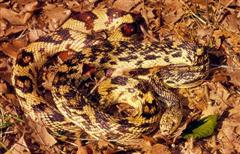Pine Snake - Northern
Scientific Name: Pituophis melanoleucus melanoleucus
Thu, 17th April, 2025 - 10:11 am GMT
Sponsor Ads:

Alternative Name
Scientific Name: Pituophis melanoleucus melanoleucusBasic Info
The Northern Pine Snake can reach up to about 7 feet in length, although they average around five feet. They are often considered one of the most beautiful snakes found in North America. The white, gray, yellow, or tan sides of the snake are marked with red, black or brown spots. The coloration is usually darker towards the neck than at the tail.
Health
Northern Pines should be kept at daytime temperatures of about 80 degrees Fahrenheit with a basking area in the high 80s. At night the temperature should be in the low 70s. Humidity levels should be low to moderate. Northern Pine snakes should be brumated for about 3 months during the winter at about 55 degrees Fahrenheit. Pine snakes will often quit feeding during the winter, regardless of enclosure temperatures and may loose too much weight if they are not cooled. Breeding After mating in the spring, the female Northern Pine Snake lays a clutch of between 3 and 24 eggs. She usually lays the eggs in a nest dug in the soil found under logs or rocks.Habitat
The diurnal Northern Pine Snake can be found in forests, woods, plains, and sand hills.Behavior
The Northern Pine Snake is one of the largest North American snakes. They can be somewhat aggressive when first introduced to captivity, but they generally settle down once they are used to their new environment. The Northern Pine Snake spends much of its time in underground burrows. When threatened, the Northern Pine Snake will usually hiss and vibrate its tail before it strikes. Some hobbyists have reported that Northern Pine Snakes may become stubborn eaters, though others have reported that the opposite is true. If you want to ensure that your Northern Pine Snake does not become a stubborn or problem eater, some have suggested feeding rats from early on. Hatchlings may be switched from mice to rats as early as possible. Feeding pinky rats from an early age should make them accept rats later in life.Origin
North AmericaHistory
Found in a very large portion of North America, the Northern Pine Snake is most common in New Jersey, West Virginia, Georgia and North Carolina. While they can be quite aggressive when first acquired, the Northern Pine Snake will often calm down with sufficient care and handling.Common Foods
They feed primarily on eggs, rodents, and lizards.Sponsor Ads:
"Gravitation is not responsible for people falling in love." -- Albert Einstein
Pine Snake - Northern
Coded by: BGID® | ALL RIGHTS RESERVED Copyright © 2000-2025
Disclaimer | Privacy | Report Errors / Contact | Credits


 Why haven't we as a collective earth met with aliens yet?
Why haven't we as a collective earth met with aliens yet?  The Best Text Adventure You Will Ever Play! The official site:
The Best Text Adventure You Will Ever Play! The official site:  Homosexual behavior stems from the mind or genetics?
Homosexual behavior stems from the mind or genetics?  World EcoSystem - Biodiversity Changes - Who is on board and who isn
World EcoSystem - Biodiversity Changes - Who is on board and who isn  Mouthwash - Mouthrinse - Mouth Sores - Healing Infections - Gingivitis
Mouthwash - Mouthrinse - Mouth Sores - Healing Infections - Gingivitis  Treatment for Depression
Treatment for Depression  Ultra radical and violent Islamist group that even rivals Al Qaeda
Ultra radical and violent Islamist group that even rivals Al Qaeda  An idea to have teachers who want to carry guns to school undergo some level of police training will be left up to local school districts and police departments.
An idea to have teachers who want to carry guns to school undergo some level of police training will be left up to local school districts and police departments.